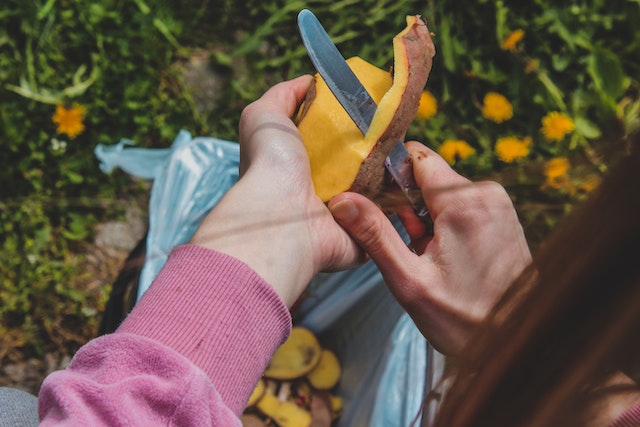
Can you eat the skin of all fruit and vegetables? Some fruits have a poisonous skin that it is better to avoid. The skin of some vegetables is too difficult to chew.
What is a fruit? A fruit is a mature, ripened ovary, and the contents of the ovary. The ovary is the female part of a flower and it contains an ovule that will develop into a seed if it is fertilized. The ovary protects the ovules until they can be fertilized. A plant is fertilized when the pollen, which comes from the male part of a flower, comes into contact with the ovaries. Some plants are self-pollinating, but most plants need a pollen transfer method. There are many different methods, such as wind, bees, and hummingbirds. Once the pollen gets to the ovule, they start to grow into seeds and the ovule begins to expand. The fruit is often filled with sugars from the plant to make it sweet and is often a bright or attractive color. This is because the purpose of the fruit is to disperse the seeds. Fruit are designed to be eaten in a way that their seeds stay whole until they can pass through the digestive canal of an animal and out the other end. The fruit needs to attract animals, but the seeds need to be of a small enough size that they don’t get chewed by the animal.
What is a vegetable? A vegetable is not as easy to describe as a fruit. A vegetable is a plant or a part of a plant used as food. We can eat the leaves, such as lettuce, the stem, such as celery, the roots, such as carrots, the tuber, such as potatoes, the bulbs, such as onions, and the flowers, such as broccoli. Not all vegetables have a skin, but most of the skins can be eaten.
What is the skin on the fruit or vegetable? The skin is the protective layer on the outside of the fruit or vegetable. It is there to protect the fruit or vegetable from pests and diseases, and to keep everything inside it. The skin also helps the fruit to balance its gas and water with the environment. The skin keeps the water inside the fruit and the oxygen outside. That is why, when you cut an apple open, it starts to go brown when it comes into contact with the oxygen in the atmosphere. The skin is also the part of the fruit that attracts the animals it uses to disperse its seeds. The fruit will have a certain color or a certain scent to attract specific insects. However, that being said, animals don’t see color the same way that we do. Research has shown that fruits mostly eaten by mammals tend to reflect more green light and fruits mostly eaten by birds tend to reflect more red light.
So, can you eat the skin of all fruit and vegetables? You can eat the skin of most fruits and vegetables. In fact, the skin has a lot of roughage in it and is good for you. It also contains a lot of nutrients and vitamins, but perhaps not as many as we’ve been led to believe. A lot of people say that the majority of the nutrients and vitamins are in the peel, but this is not true. According to the US Department of Agriculture, there is very little difference in the nutritional content of an apple with and without the skin.
Which skins can’t we eat? There are two kinds of skins that we can’t eat. The first kind we can’t eat because they are too tough for us. The second kind we can’t eat because they are harmful to us. We can’t eat the skins of fruits and vegetables like pineapple and pumpkins because it is too tough to chew. You can physically eat them, but you’d need to boil them for a long time so they are soft enough to chew.
We can’t eat the skins of fruits like lychee and ackee before they are ripe because they contain a toxin called methylene cyclopropyl-glycine. If you are malnourished, or have low blood sugar, this toxin can be extremely harmful because it blocks the production of sugar. They have evolved this toxin as a defense mechanism to stop animals eating the fruit before the seeds are ready for dispersal. Animals learn when it is ok to eat the fruit. The skins of some potatoes are dangerous as well. If the potato skin has gone green, it contains a toxic substance called glycoalkaloid, which can cause nausea, diarrhea, confusion, headaches, and, rarely, death. And, last but not least, the skins of mangoes are poisonous. They contain urushiol, which is the same toxin that is found in poison ivy. Most people will probably be ok, but some people are very sensitive to the toxin.
So, we can eat the skins of most fruits and vegetables, but there are some we should avoid. And this is what I learned today.
Sources
https://www.neogen.com/neocenter/blog/science-why-are-fruits-so-colorful/
https://en.wikipedia.org/wiki/Peel_(fruit)
https://www.eater.com/ad/21560922/science-behind-peels-apeel-coating
https://www.yummly.com/dish/679008/peel-this-not-that-a-quick-fruit-and-vegetable-guide
https://extension.psu.edu/fruit-quality-how-do-fruit-get-their-flavor
https://www.ehow.com/info_7755421_happens-after-pollination-flowers.html
https://www.twinkl.jp/teaching-wiki/ovary-plant
https://www.treehugger.com/poisonous-fruits-and-vegetables-avoid-4858734
